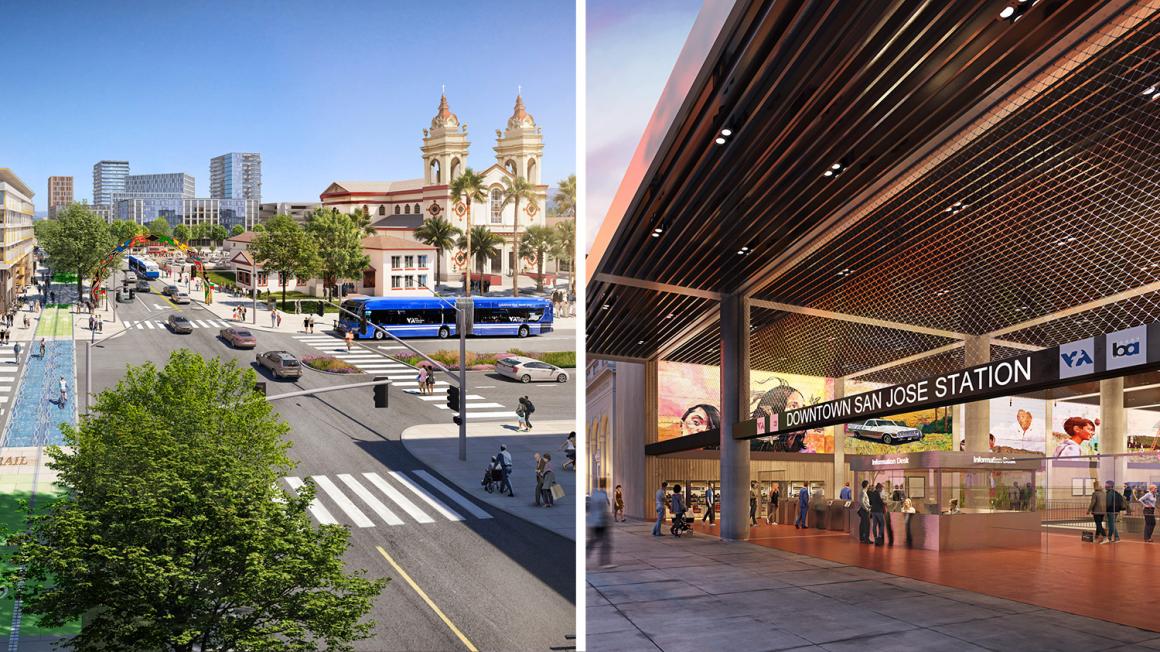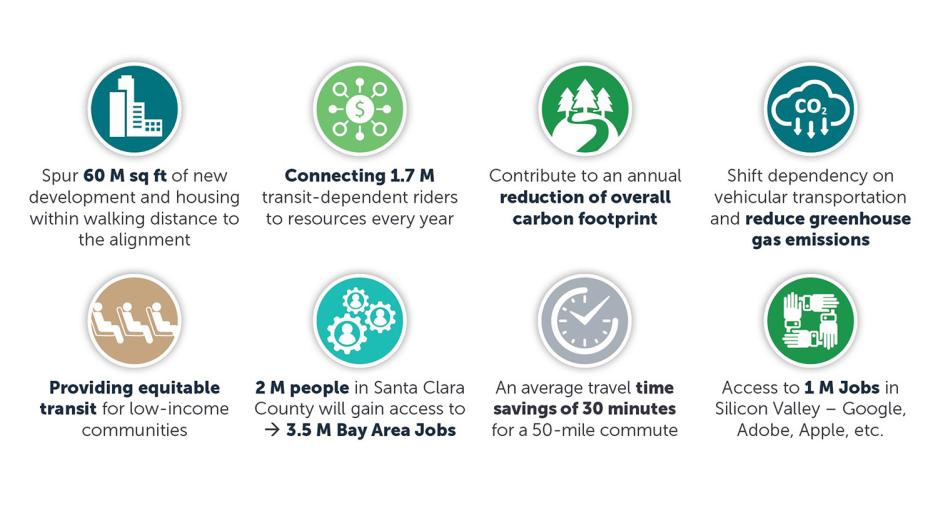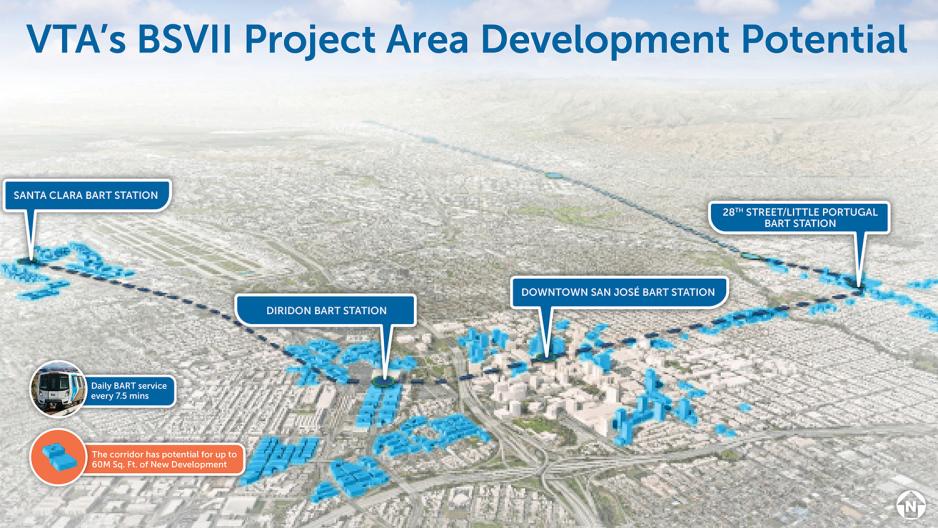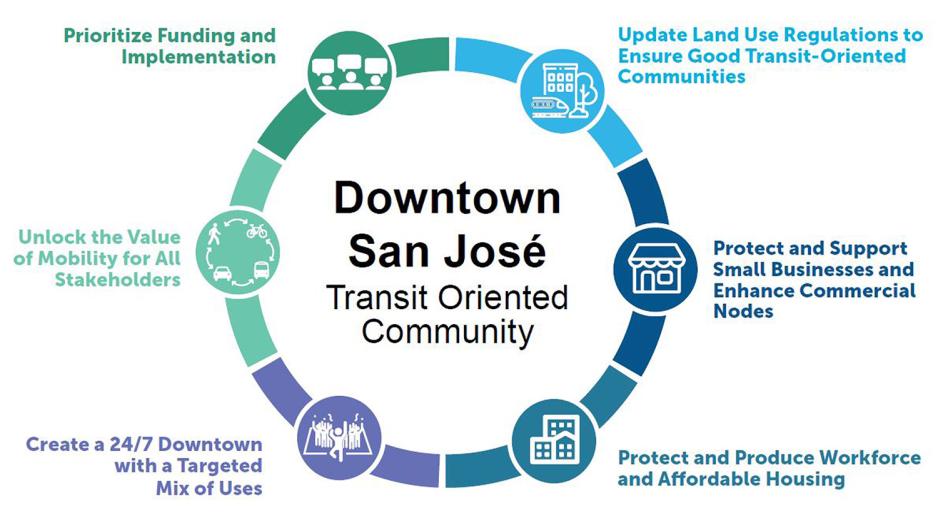BART and the Region
The Bay Area Rapid Transit (BART) system significantly enhances the Bay Area's mobility, connecting major hubs and stimulating local economies by boosting local businesses. By offering an alternative to vehicular dependency, BART helps to alleviate traffic congestion and reduces greenhouse gas emissions. This accessible transit option promotes social equity, ensuring residents can easily reach jobs, education, and essential services. BART’s integration with local transit systems throughout the Bay Area helps foster sustainable, pedestrian-friendly developments, thereby reducing the region’s fossil fuel dependence. Even beyond transportation, the system seamlessly connects residents and tourists to the Bay Area's cultural, recreational, and entertainment venues, ultimately elevating the region's quality of life.
BART and Santa Clara County
With construction anticipated soon, VTA’s BART Silicon Valley Phase II Extension (VTA's BSV II) is a six-mile, four-station extension of BART service from Berryessa/North San José Station into east and downtown San José to the City of Santa Clara. The VTA's BSVII Project is planned to include an approximately five-mile subway, three stations with underground platforms (28th Street/Little Portugal, Downtown San José, and Diridon), one ground-level station (Santa Clara), a train maintenance and storage facility, and additional facilities. The Phase I extension, which began service in June 2020, extended BART service from Alameda County into Santa Clara County, with stops at Milpitas and Berryessa/North San José.
In total, the Phase I and Phase II extensions are estimated to carry over 100,000 passengers each weekday to destinations throughout the Bay Area by 2040. Completion of Phase II will finally "ring the bay" with frequent rail service, while connecting 1.7M transit dependent riders to resources.
VTA's BSVII’s Economic Benefits
With big investment comes big rewards. The Phase II Project is expected to spur approximately 75,000 jobs—including almost 43,000 jobs directly related to the project, and another 32,000 jobs tied indirectly or through the investment from the project.
The four future stations in Santa Clara and San José will serve approximately 54,600 average weekday riders by 2040, with a projected 27,900 daily ridership at the Downtown San José Station alone. These ridership projections for the four new stations represent a substantial overall increase in anticipated BART ridership. The two stations adjacent to San José State and Santa Clara Universities are projected to serve over 5,600 university student trips per day, not including trips taken by staff and faculty. Once VTA's BSVII is completed, nearly 50% of trips to and from the four new stations—a total of 32,900 by 2040—will be non-work-related trips.
VTA's BSVII: A Symbiotic Investment in the Region and its Future
It's no secret that large infrastructure projects can spur development and the transformational Phase II Project is no different. For over a decade, the cities of San José and Santa Clara, along with the private sector have been preparing for this extension further into Silicon Valley.
In 2022, San José became one of the largest jurisdictions in the country to eliminate parking minimums, while introducing a robust Parking Transportation Demand Management (TDM) policy. To accommodate the potential 60M square feet of new development along the BSVII corridor, San José updated its Urban Village/Master Plans, including the Downtown and Diridon Area/Downtown West. Additionally, building height limits were raised along the corridor in coordination with the FAA. Meanwhile, Santa Clara began the advancement of its Santa Clara Station Area Specific Plan, targeting the development of a 244-acre focus area.
Over in the private sector, Google earned unanimous City Council approval for its 80-acre Downtown West development project and TikTok is hiring for 1,000 positions at its San José campus, bordering the future Santa Clara BART Station. Jay Paul’s 200 Park Avenue recently introduced 1M square feet of Class A Commercial Office Space, while Adobe has settled into its fourth and newest 720K square-foot Founders Tower and the Bay Area will witness its first female pro soccer team, BayFC, competing at PayPal Park beginning in 2024.
In terms of housing, the Fay by Morro in the SoFA District is constructing 336 market-rate units, and around Diridon Station, over 750 affordable homes are emerging in projects like The Arya, Delmas Village, Auzerais Apartments, and more. Meanwhile, Hunter Partners is constructing a mixed-use development near the Santa Clara BART Station, featuring over 1,500 residential units, a hotel, retail spaces, and a park.
VTA's BSVII: A Solution to the Region’s Forecasted Growth
With selective policy levers applied, a whopping 50% of Plan Bay Area’s 2050 projected growth for Santa Clara County can be accommodated on less than 1% of the County’s urbanized land along higher capacity transit corridors. This translates to 222K new residential units and 290K jobs captured within the County.
For its part, VTA's BSV II extension project to San José and Santa Clara, brings with it the potential for approximately 60 million square feet of new development within its corridor. This is in addition to the extensive development that occurred implementing the Phase I extension, as evidenced by the phenomenal growth that occurred around the Milpitas BART Station—development that occurred well in advance of BART service! The BSVII extension also provides a once-in-a-century opportunity to create equitable, walkable, vibrant, and affordable places to live, work, shop, and play through compact, mixed-use development around transit. By reducing the reliance on automobiles, the BSV II extension can lead to decreased greenhouse gas emissions and reduced air pollution.
New Development Potential by VTA's BSVII Station Areas
- Santa Clara Station: 12.7M Square Feet
- Diridon Station: 16M+ Square Feet
- Downtown San José: 23.8M Square Feet
- 28th Street/Little Portugal: 8.5M Square Feet
Concentrating Development Near VTA's BSV II
Since 2018, VTA—in partnership with San José, Santa Clara, and BART—has studied the benefits and development potential that could be realized from VTA's BSV II project, creating strategies focusing on affordable housing, mobility, equity, and community development. The strategies developed were captured in station-specific Transit Oriented Communities (TOCs) Playbooks, with each Playbook focusing on the Big Moves needed to realize the potential. By June 2020, with an additional $1.58M from the Federal Transit Administration, VTA progressed on implementing these strategies, including updating plans, establishing investment districts, and formulating design frameworks for key areas, including the 28th Street/Little Portugal station.
By design, high-density development adjacent to high quality transit such as VTA's BSV II is easily accessible and makes transit use easy and convenient. This type of development champions pedestrian and bicycle-friendly street networks, encouraging walking and cycling as alternative transport methods, enhancing community bonds, and ensuring safety. It also emphasizes seamless connectivity for residents and workers between various transport modes such as trains, light rail, buses, and pedestrian pathways, facilitating smooth transitions. Lastly, with the emphasis on public transportation, these areas often have reduced parking requirements, which reduces costs for developers, reserves land for more valuable uses such as housing and parks, and encourages residents to use transit more frequently.
This results in less driving, more walking, and reduced impacts on existing communities. This development also supports active street-level uses, creating opportunities for engaging storefronts and places to eat, shop, and socialize. These spaces can improve the quality of life in our cities and communities and fulfill community, city, and regional goals.
Big Moves for Downtown San José BART Station
VTA's BSV II and Plan Bay Area 2050
As the VTA's BSV II project advances onward, VTA is committed to fostering growth along the Phase II corridor while prioritizing anti-displacement programs, aiming to create equity for both new and existing community members. A county-wide parcel analysis indicated that the majority of Santa Clara County's growth through 2050 can conveniently be positioned within half a mile of present and planned transit routes. By centering development on these transit corridors, Silicon Valley can flourish, cater to housing demands, and curb escalating congestion. VTA not only promotes high-density development along these pathways through education, funding, and technical assistance to local jurisdictions but also acknowledges the imperative of introducing new policies, especially in Equity Priority Communities, to prevent displacement and further cultivate Transit-Oriented Communities.



